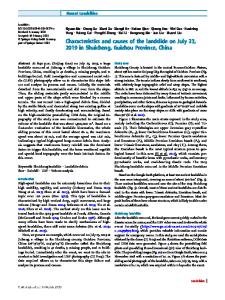Occurrence Modes of Niobium in Kaolin Clay From Guizhou, China
- PDF / 6,999,873 Bytes
- 8 Pages / 595.276 x 790.866 pts Page_size
- 14 Downloads / 349 Views
TECHNICAL NOTE
Occurrence Modes of Niobium in Kaolin Clay From Guizhou, China Li Zhu 1 & Hannian Gu 2
&
Yongqiong Yang 1 & Hanjie Wen 3,4 & Shengjiang Du 3 & Chongguang Luo 3 & Ning Wang 2
Received: 28 April 2020 / Accepted: 16 November 2020 # Society for Mining, Metallurgy & Exploration Inc. 2020
Abstract Niobium in kaolin clay from the Late Permian sequences was reported in the range of several hundreds of micrograms per gram and was considered as a potential resource for its high concentrations and large areal distribution. Ti-bearing minerals associated with kaolin clay were identified as the main host phase for niobium in some case studies. However, the correlation between the concentration of niobium and titanium is poor, and the types of Ti-bearing minerals and modes of occurrence of niobium are not clear. Typical kaolin clay samples from the Late Permian sequences from southwest China were characterized, and the final products derived from kaolin clay sample were investigated using XRF, ICP-MS, XRD, SEM, and TEM (EDS). The results reveal that there were three types of TiO2 mineral phases in the clay samples: (a) massive TiO2 minerals and (b) aggregates of nano TiO2 minerals did not contain niobium while (c) granular TiO2 minerals were the source of niobium from the EDS analysis. The granular TiO2 minerals included anatase and rutile, both of which were the sources of niobium in kaolin clay in the current study. The findings are of great theoretical implication for source and origin study of Ti-bearing minerals and guidance for separation and recovery of niobium from kaolin clay. Keywords Niobium occurrence . Titania . Morphology . Kaolin clay
1 Introduction Niobium (Nb) is a strategic metal with extensive uses in many fields, and the demand for Nb in the world market has been increasing for the past decades due to its application in steel and alloy industries [1, 2]. Pyrochlore, columbite, fersmite, and fergusonite occur in nature as common niobium-bearing minerals [3]. Magmatic Nb-Ta (tantalum)-Sc (scandium) deposits and sedimentary Nb-Ta deposits are the two major categories for geological and geogenic classification [4]. The sedimentary Nb-Ta deposits include two sub-categories, i.e.,
* Hannian Gu [email protected] 1
School of Geographic and Environmental Sciences, Guizhou Normal University, Guiyang 550025, China
2
Key Laboratory of High-Temperature and High-Pressure Study of the Earth’s Interior, Institute of Geochemistry, Chinese Academy of Sciences, Guiyang 550081, China
3
State Key Laboratory of Ore Deposit Geochemistry, Institute of Geochemistry, Chinese Academy of Sciences, Guiyang 550081, China
4
University of Chinese Academy of Sciences, Beijing 100049, China
Nb-P (phosphorus)-Ti (titanium) laterites and bauxites and Sn (stannum)-Ta-Nb placer deposits. Worldwide, more than 95% of niobium ore reserves were evaluated in Brazil and Canada. The unbalanced distribution of niobium resources and the increasing industrial demand for niobium have encouraged the exploitation and proce
Data Loading...











